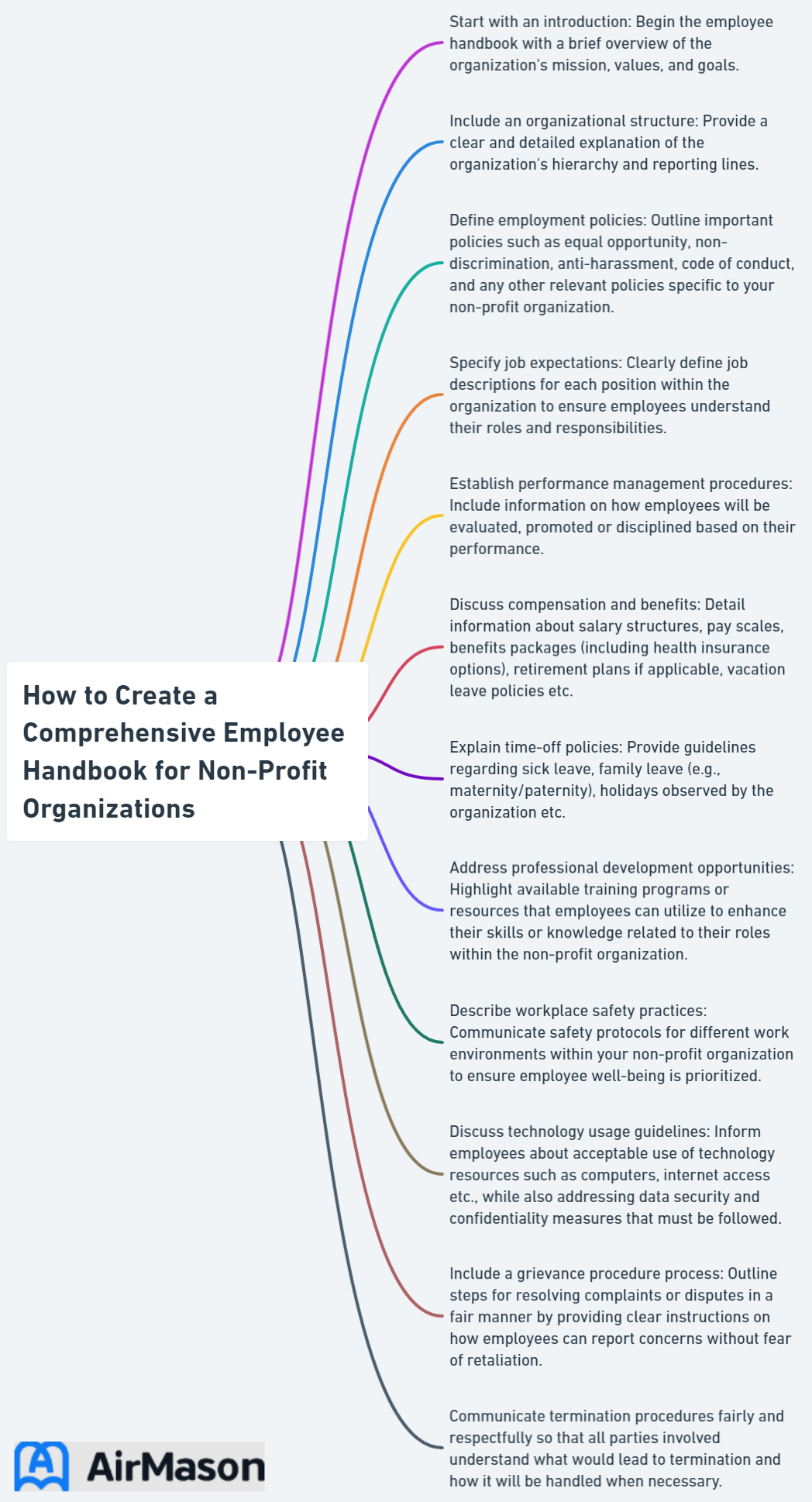
Are you a nonprofit organization looking to create a comprehensive employee handbook? Look no further! In this blog post, we will guide you through the essential steps to develop an effective employee handbook for non profit tailored to your nonprofit’s unique needs. By the end of this post, you will have a solid understanding of the crucial components of a nonprofit employee handbook and how to customize and implement it to ensure a successful and thriving organization.
Key Takeaways
- Employee handbooks are essential for nonprofits to ensure legal compliance, risk management and organizational standards.
- The employee handbook should include mission and values, policies & procedures, employee rights & responsibilities and benefits & resources.
- Involve stakeholders in the creation of an employee handbook to promote a unified understanding among employees while ensuring legal compliance with regular review/updates.
Create Employee Handbook
When embarking on the task to create employee handbook, it’s essential to outline the company’s policies and expectations clearly. Crafting a comprehensive guide is not just about compliance; it’s an opportunity to communicate the organization’s values and culture. Begin the process of creating an employee handbook by detailing the company’s mission and vision, followed by a thorough exploration of policies related to workplace conduct, benefits, and procedures. By focusing on the “create employee handbook” process with attention to detail, you can ensure that your employees have a valuable resource that guides them through their professional journey within the organization.
The Significance of Employee Handbooks for Nonprofits
An employee handbook is of paramount importance for nonprofit organizations in terms of legal copliance, risk management, and establishing organizational standards. The National Council of Nonprofits advocates that all charitable nonprofits have access to an expert to seek advice when queries arise related to employment matters. A good employee handbook serves to effectively communicate essential information to employees, especially in nonprofit organizations. By having a thorough employee handbook, nonprofit employers facilitate a shared understanding and minimize the possibility of confusion or miscommunication.
Creating an employee handbook that mirrors your organization’s policies and mission, while conforming to federal and state laws, is vital. Consulting with legal counsel while creating an employee handbook is a key step to secure legal compliance and minimize liability. Including clear personnel policies in an employee handbook helps to protect the board of directors from legal issues such as back withholding taxes and associated penalties.

Key Components of an Effective Nonprofit Employee Handbook
This section will cover the vital elements of a nonprofit employee handbook, including:
- Mission and values
- Policies and procedures
- Employee rights and responsibilities
- Benefits and resources
These components serve as a foundation for creating a comprehensive and effective employee handbook tailored to your nonprofit’s unique needs.
Organizational Mission and Values

The inclusion of the organization’s mission and values in the employee handbook sets the tone and provides context, making it an essential step. It is advisable to review and potentially revise the mission and values statements in the employee handbook at least once a year or more frequently if necessary. This ensures that the statements accurately reflect the organization’s current mission and values as it progresses.
Incorporating the organization’s mission and values into the employee handbook fosters a sense of unity and shared understanding among employees. This helps employees align their daily actions with the organizational objectives, ultimately contributing to the overall success of your nonprofit.
Policies and Procedures
The significance of explicitly delineating policies and procedures in the employee handbook lies in its ability to guarantee uniformity and openness. Policies such as vacation time, sick leave, and sexual harassment should be incorporated into the employee handbook. These policies not only ensure legal compliance but also create a transparent and fair work environment for all employees.
To craft an effective pay equity policy for a nonprofit employee handbook, consider the following steps:
- Define pay equity.
- Conduct a pay equity analysis.
- Establish compensation guidelines.
- Prohibit discrimination.
- Provide transparency.
- Regularly review and update the policy.
Outlining clear organization’s policies and procedures in the employee handbook is a way for your nonprofit organization to demonstrate its commitment to fairness and equal treatment for all employees.
Employee Rights and Responsibilities
The employee handbook should outline expectations for employee behavior, performance, and compliance with policies. Delimiting employee rights and responsibilities in a nonprofit handbook is of great significance as it furnishes employees with knowledge on the organization’s policies, regulations, and benefits. Moreover, it aids in safeguarding the nonprofit organization from baseless claims by establishing clear expectations for employees and defining roles and responsibilities, augmenting employee experience and performance.
Employee rights and responsibilities facilitate adherence to organizational policies and foster a healthy employment relationship through human resources by ensuring job duties are met through:
- Effective communication
- Positive reinforcement
- Establishing expectations
- Ensuring legal compliance
- Ensuring consistency and fairness
A transparent and accountable work environment that fosters success and growth can be created by clearly defining employee rights and responsibilities in the employee handbook.
Benefits and Resources
Employees should refer to the employee handbook for information regarding:
- Benefits
- Health and wellness programs
- Professional development opportunities
- Support services
Including benefits and resources in the employee handbook is beneficial to employees, as it provides them with helpful information.
Outlining the benefits and resources available to employees in the employee handbook helps your nonprofit organization demonstrate its commitment to employee well-being and growth. This not only helps attract and retain top talent but also contributes to a positive and supportive work environment where employees can thrive and excel.
Customizing Your Employee Handbook for Your Nonprofit

Now that we have covered the key components of an effective nonprofit employee handbook, let’s focus on customizing the handbook to suit the specific needs and culture of your nonprofit organization. This includes involving stakeholders, ensuring legal compliance, and reflecting your organization’s unique culture.
Menards Employee Handbook
Navigating the Menards employee handbook is essential for a successful onboarding experience and a harmonious work environment. The Menards employee handbook provides comprehensive guidelines, outlining the company’s policies, expectations, and benefits. Employees can refer to the Menards employee handbook for insights into workplace culture, professional conduct, and the resources available to them. Whether you’re a new hire or a seasoned team member, regularly consulting the Menards employee handbook ensures that you stay informed about the latest updates and policies, fostering a positive and compliant workplace for all.
Involving Stakeholders
For a comprehensive and pertinent employee handbook, the involvement of a variety of stakeholders during its formation is vital. A diverse group of stakeholders, including members of a personnel committee and individuals knowledgeable in local employment law, should be consulted during the development of an employee handbook.
Including staff members on the personnel committee for developing an employee handbook will ensure that the policies address practical problems encountered in daily management of the organization, and will aid in ensuring that the revised language is easily understood by those who must comply. Involving a diverse group of stakeholders enables your nonprofit organization to create an employee handbook that resonates with the unique needs of your organization.
Legal Compliance
Ensuring the employee handbook, also known as the employee manual, adheres to legal compliance is vital to guarantee conformity with federal and state laws and regulations. An employee handbook must adhere to various federal laws, such as the Family and Medical Leave Act (FMLA), Fair Labor Standards Act (FLSA), and Title VII of the Civil Rights Act.
Additionally, state-specific regulations, which are governed by state law, should be incorporated into a nonprofit’s employee handbook, which may differ depending on the state of operation. It is imperative to seek counsel from legal professionals or HR personnel with knowledge of the state’s employment laws to guarantee adherence.
The assurance of legal compliance helps your nonprofit organization minimize risk and foster a transparent and fair work environment for all employees.
Reflecting Organizational Culture
Organizational culture within a nonprofit context is comprised of the shared beliefs, values, attitudes, and behaviors that form the working environment and direct the actions of individuals within the organization. For employee alignment with the values, mission, and vision of the organization, it’s vital to incorporate your organization’s unique culture and values into the employee handbook.
To effectively reflect your nonprofit’s organizational culture in the employee handbook, consider incorporating language unique to your organization’s culture, including its history and anecdotes that tell the story. Additionally, ensure that the tone and style of the handbook align with the values and mission of your nonprofit.
Reflecting your organization’s unique culture in the employee handbook fosters a sense of belonging and identity among employees, thus cultivating a positive work atmosphere and encouraging employee engagement.
Regularly Reviewing and Updating Your Employee Handbook

Ensuring that all the data in the employee handbook remains current and reliable is of paramount importance. To ensure your employee handbook is up-to-date, it is recommended that a nonprofit organization review and update its employee handbook at least once annually.
Regularly reviewing and updating your employee handbook not only ensures legal compliance but also helps to address any changes in company policies, procedures, and philosophy. Keeping your employee handbook current and relevant aids your nonprofit organization in maintaining a transparent, accountable work environment that fosters success and growth.
Communicating and Implementing Your Employee Handbook

Once a comprehensive employee handbook tailored to your nonprofit’s unique needs has been created, it’s important to make all employees aware of the handbook and to address any questions they may have. The most effective methods for distributing an employee handbook within a nonprofit organization include:
- Making it available electronically or providing hard copies
- Distributing or posting revised handbooks and collecting signed acknowledgments
- Establishing a distribution method during new-hire orientation or handbook rollout
To ensure employees understand the handbook, consider utilizing the following methods:
- Workshops or seminars
- Online courses or e-learning modules
- Mentors or trainers
- Stories and testimonials
- Questions and discussions
Effectively communicating and implementing your employee handbook enables your nonprofit organization, led by an executive director, to create a transparent and accountable work environment that fosters success and growth.
Summary
In conclusion, a comprehensive and effective employee handbook is vital for the success of any nonprofit organization. By including essential elements such as mission and values, policies and procedures, employee rights and responsibilities, and benefits and resources, your employee handbook serves as a crucial tool to ensure legal compliance, risk management, and setting organizational standards.
Customizing your employee handbook to reflect your nonprofit’s unique needs and culture, involving stakeholders, ensuring legal compliance, and regularly reviewing and updating the handbook are all critical steps in creating a solid foundation for your organization’s success. With a well-crafted employee handbook in place, your nonprofit organization is better equipped to foster a positive work environment, retain top talent, and ultimately achieve its mission.
Why Are Employee Handbooks Important
Employee handbooks play a crucial role in establishing clear expectations and guidelines within a company. “Why are employee handbooks important?” you might ask. Well, these documents serve as a comprehensive resource, outlining company policies, procedures, and expectations for employees. They help foster a consistent understanding of the organization’s values and standards, ensuring a harmonious work environment. Furthermore, employee handbooks can serve as a valuable reference for both employers and employees, providing insights into rights, responsibilities, and the overall culture of the workplace. In essence, a well-crafted handbook contributes to better communication, employee satisfaction, and a more organized and productive workforce.
Frequently Asked Questions
What should be in a nonprofit handbook?
A nonprofit handbook should include a statement of at-will nature of employment, a statement that it is not a contract, an employee acknowledgement of receipt and signature, nondiscrimination and sexual harassment policies, and employee grievance and discipline procedures to keep all employees informed and on the same page.
What is the employee manual for a nonprofit organization?
The employee manual for a nonprofit organization provides employees with information on the organization’s policies, rules, and benefits, as well as outlining the terms and conditions of employment, clarifying workplace rules, and communicating expectations. It serves to keep everyone informed and on the same page, including providing a guide to help employees understand the ins and outs and dos and don’ts of the organization.
Does a nonprofit board approve the employee handbook?
Yes, a nonprofit board should approve the employee handbook after revisions and legal review have been conducted.
How often should a nonprofit organization review and update its employee handbook?
It is recommended that a nonprofit organization review and update its employee handbook at least once a year.
What is the importance of involving stakeholders in the development of an employee handbook?
Involvement of stakeholders in the development of an employee handbook is essential to create a comprehensive, relevant document that addresses daily management issues.